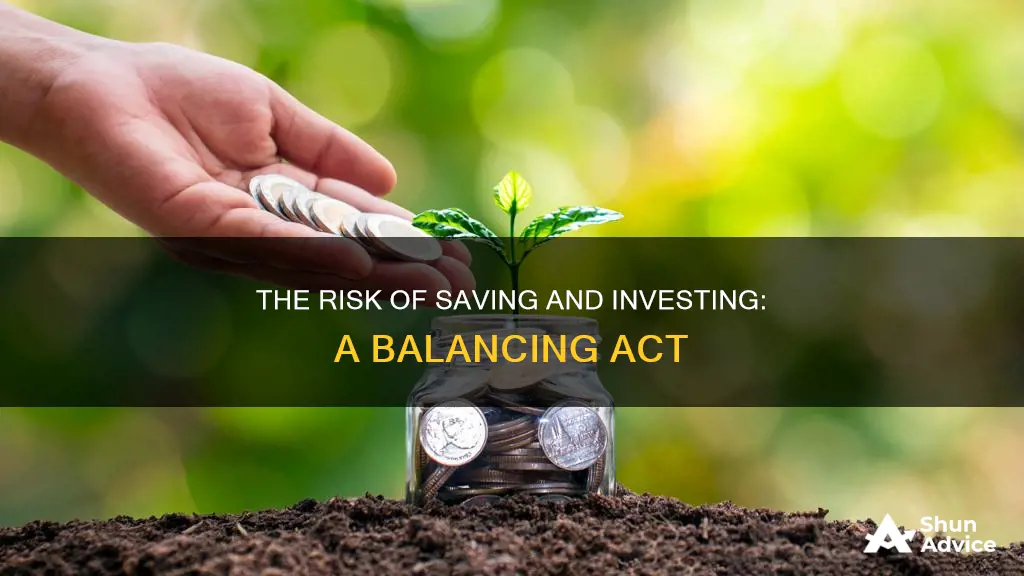
Saving and investing are two very different concepts, and the main difference between them is risk. Saving entails very little risk, as it is unlikely to lose you money, but it is also unlikely to make you money. On the other hand, investing always involves some level of risk, and there is no guarantee that you will make money or even get back what you've invested.
| Characteristics | Values |
|---|---|
| Risk | The chance that an outcome or investment's actual gains will differ from an expected outcome or return |
| The possibility of losing some or all of an original investment | |
| Savings | Considered secure |
| Unlikely to lose you money | |
| Unlikely to make you money | |
| Investments | Riskier than savings |
| May lose you money | |
| May make you money over the long term |
What You'll Learn
- Savings accounts are considered secure and are unlikely to lose you money, but they also won't make you money
- Investments are riskier than savings accounts as you could lose money
- Investments can also make you money over the long term
- Diversification across several holdings can help reduce risk
- It's important to do your research and understand the potential risks associated with different types of investments

Savings accounts are considered secure and are unlikely to lose you money, but they also won't make you money
Savings accounts are considered secure and are unlikely to lose you money, but they also won't make you much money. Savings are short-term access accounts that are used day-to-day. They are a good option for those who want to have money set aside for unexpected expenses or emergencies. Savings accounts do not generally pay a high rate of interest, but they are secure and you can access the money at short notice.
On the other hand, investments are considered more long-term. They involve committing your money to an asset with the goal of growing its value over time. Investments come with the risk of losing money, but they also offer the potential for higher returns.
The main difference between savings and investments is risk. Savings accounts are a low-risk option, while investing always involves some level of risk. There is no guarantee that you will make money from investments, and you may even lose your original investment. However, diversification across several holdings can help mitigate this risk.
It's important to consider your financial situation, goals, and risk tolerance when deciding whether to save or invest your money. Both options have their pros and cons, and it's crucial to understand the potential risks and rewards associated with each.
Investing Guide: A Handbook for Indians
You may want to see also

Investments are riskier than savings accounts as you could lose money
Savings accounts are generally considered to be a secure way to store your money. They are short-term access accounts that can be used day-to-day and are unlikely to lose you money. However, they also won't make you money as they don't pay a high rate of interest.
Investments, on the other hand, are riskier as there is a chance you could lose some or all of your original investment. This is because investments are generally considered to be longer-term commitments, and there is no guarantee that you will make money. The value of an investment can go down as well as up, and it is important to understand the potential risks associated with different types of investments before committing any money.
Some people may choose to save rather than invest due to the sense of security that comes with having money set aside in a savings account. It is generally recommended to have an emergency fund in a savings account to cover several months' worth of expenses before considering investing.
Overall, the main difference between savings and investments is the level of risk involved. While investments may offer the potential for higher returns, they also carry a higher chance of losing money.
Options Trading: A Personal Investment Portfolio Strategy?
You may want to see also

Investments can also make you money over the long term
Saving and investing are two different concepts with different levels of risk. Savings are short-term access accounts that are used day-to-day and are considered secure. They do not generally pay a high rate of interest, but they are unlikely to lose you money.
Investments, on the other hand, are considered more long-term. They carry a higher risk of losing money but also have the potential to make you money over time. This is because investments are about committing your money to an asset with the goal of increasing its value over a longer period. For example, your main residence is considered an investment.
The key difference between saving and investing is the level of risk involved. By definition, saving entails very little risk, whereas investing always involves some level of risk. This risk is defined as the chance that an investment's actual gains will differ from the expected outcome or return. In other words, there is a possibility of losing some or all of the original investment.
Despite the risks, investments can make you money over the long term. This is particularly true if you understand the investment you are making and have a long-term perspective. It is important to do your research and understand the potential risks associated with different types of investments. Diversification across several holdings can also help to manage risk.
Land Investing: Make a Living from Property
You may want to see also

Diversification across several holdings can help reduce risk
Diversification across several holdings can help reduce the risk of losing money. Investments always involve some level of risk, and there is no guarantee that you will make money or even get back what you've invested. However, diversification can help mitigate this risk. By spreading your investments across multiple assets or holdings, you reduce the likelihood of losing all your money if one particular investment performs poorly.
When investing, it is important to do your research and understand the potential risks associated with different types of investments. Historical behaviours and outcomes can be used to assess the risk of an investment. Standard deviation is a common metric associated with risk, as it measures the volatility of asset prices in comparison to their historical averages.
It is also important to consider your financial situation, goals, and risk tolerance when deciding whether to save or invest your money. Savings accounts are generally considered secure, as there is little risk of losing money. However, savings accounts also typically pay a low rate of interest, so they are unlikely to make you money. On the other hand, investments have the potential to grow your money over the long term but come with the risk of losing some or all of your original investment.
Therefore, diversification across several holdings can be a prudent strategy to reduce the risk of losing money when investing. By spreading your investments and doing your research, you can better manage the risks associated with investing.
Ally Managed Invest: Fees, Benefits, and Drawbacks
You may want to see also

It's important to do your research and understand the potential risks associated with different types of investments
Investing, on the other hand, comes with the risk of losing money. Investments are considered more long-term and committing your money to an asset in order to grow its value over a longer timeframe. Risk is defined in financial terms as the chance that an investment's actual gains will differ from an expected outcome or return. This includes the possibility of losing some or all of an original investment.
It is possible and prudent to manage investing risks by understanding the basics of risk and how it is measured. Diversification across several holdings can help. Before you put any money into investments, it is recommended to have enough savings put away in an emergency fund to cover several months of expenses. The answer to whether you should save or invest your money depends on your particular financial situation, goals, and risk tolerance.
Investment Advisors vs Managers: What's the Real Difference?
You may want to see also
Frequently asked questions
Saving entails very little risk and is considered secure, but it is also unlikely to make you money. Investing, on the other hand, comes with the risk of losing money, but it may also make you money over the long term.
Risk is defined as the chance that an investment's actual gains will differ from an expected outcome or return. This includes the possibility of losing some or all of an original investment.
The pros of investing are that you may make money over the long term. The cons are that there is no guarantee that you will make money or even get back what you've invested.
Before investing, it is important to have enough savings put away in an emergency fund to cover several months of expenses, and enough money in your checking account to cover all of your short-term needs. It is also important to do your research and understand the potential risks associated with different types of investments.







